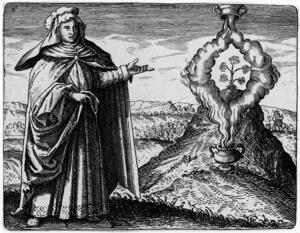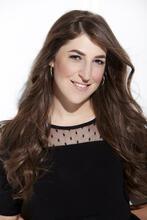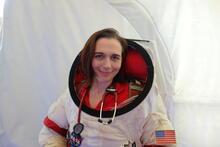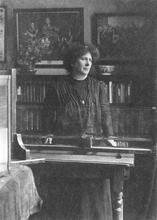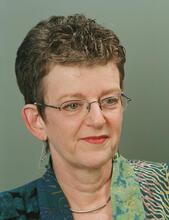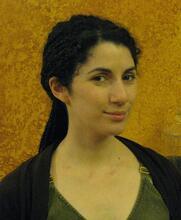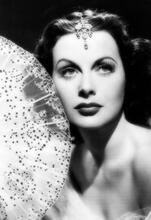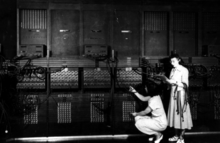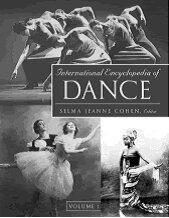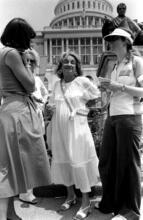Maria the Jewess
Alchemist Maria the Jewess. From Daniel Stolcius, Viridarium chymicum figuris cupro incisis adornatum, et poeticis picturis illustratum. Frankfort: L. Jennis, 1624. From the Wellcome Collection.
Maria the Jewess (ca. 1st– early 3rd cent. C.E.) was known to medieval alchemists as a major founder of alchemy and was the first non-mythical Jewish woman to write and publish works under her own name. Maria is generally regarded as the first actual alchemist who is not a mythical figure. According to the Zosimos of Panoplis, she started an alchemical academy in Alexandria, Egypt, and she reportedly excelled at the process of transmutation of base metals into gold. Zosimos wrote a brief account of Maria’s philosophy, called The Four Bodies Are the Aliment of the Tinctures. Maria the Jewess invented several important pieces of chemical apparatus and was also known for a variety of mystical and alchemical sayings.
Ancient Alchemy
In Hellenistic and Roman times, philosophers in the Mediterranean region generally accepted Aristotle’s view of matter: all earthly objects were made of four elements—air, fire, earth, and water. These were not the actual substances themselves, but ideal embodiments. Within these four elements were four qualities in opposing pairs: cold/hot and wet/dry. It was thought that any substance could be transformed into any other substance if the appropriate proportions of the Four Elements were known, by adjusting the relative balances of the four qualities. A fifth element or quintessence, called ether, was said to make up the heavens. One of Egyptian alchemy’s main aims was transmutation (i.e., conversion) of cheap metals, such as lead, into gold, usually envisioned in four steps: (1) melanosis, killing the base metal and blackening it; (2) leukosis, whitening the metal with arsenic compounds; (3) xanthosis, yellowing silver into gold, perhaps involving sulfur; and (4) iosis, turning the metal to violet, thus creating a metal that can convert other materials.
Maria the Jewess
Maria the Jewess (ca. 1st– early 3rd century C.E.) was known to medieval alchemists as a major founder of alchemy and was the first non-mythical Jewish woman to write and publish works under her own name (though the originals are now lost). Among the names she was called in alchemical literature were Mary the Jewess, Miriam the Jewess, Maria Prophetissima, Maria Prophetissa, Mary Prophetissa, Miriam the Prophetess, Maria Hebrea, and Maria the Hebrew. The “prophet” title dates at latest from the early sixteenth century. Many medieval sources confused her with Miriam, the sister of Moses, as well as with Mary Magdalene. Raphael Patai argues that this confusion resulted from the belief that “identity of names signified identity of persons.” He also notes that, as her lifetime receded into myth, the era in which she lived was pushed further and further back in time.
Most historians regard Maria as the first actual alchemist, one who is not a mythical figure. According to the Greco-Egyptian alchemist Zosimos of Panoplis in Upper Egypt (3rd– 4th century C.E.), Maria the Jewess (whom he also called “the divine Maria”) started an alchemical academy in Hellenistic Alexandria, Egypt, and reportedly excelled at the process of transmutation. A short book by Zosimos called The Four Bodies Are the Aliment of the Tinctures focuses entirely on her philosophy. Other Jewish Hellenistic alchemists are known, but only Maria the Jewess’s fame endured in both Arab and European alchemy.
Maria’s Alchemical Work and Inventions
Maria the Jewess used a variety of apparatuses, including ovens made of clay, metal, and glass. To seal the joints between the various parts, she used wax, fat, paste made of starch, and clay mixed with fat. According to Zosimos, she found glass items useful because they allowed the reactions to be viewed without disturbing them, and they allowed relatively safe work with mercury and sulfurous (or arsenical) compounds, both known to be toxic. She may have been the first person to mention hydrochloric acid, a mineral acid whose discovery is usually attributed to later, medieval Arab alchemists.
Maria the Jewess is credited with inventing the balneum Mariae, double-boiler, or laboratory water bath, which even today is called the bain-Marie in French and the Marienbad in German. She also supposedly invented the tribikos, a kind of distillation still with three spouts, and the kerotakis, an extractor with a metallic palette supported inside a vacuum container for holding vapors; the palette held a metal sample, upon which various warmed vapors such as sulfur or mercury would act. In the late nineteenth century, the German chemist Franz von Soxhlet modified the kerotakis into the modern “Soxhlet extractor,” which is used to this day.
According to Zosimos, Maria the Jewess ground cinnabar [mercury (II) oxide] with mortars and pestles of lead and tin. By the late tenth century, the Arab book Kitāb al-Fihrist (Book Catalogue), by Ibn Al-Nadim, placed her among the 52 most important alchemists known and credited her synthesizing a brownish-purple pigment known as caput mortuum.
Maria’s Sayings and Writings
Later alchemists gave Maria credit for a number of sayings, including “Just as a man is composed of four [Aristotelian] elements, likewise is copper, and just as a man results from the association of liquids, of solids, and of the spirit, so does copper” and “Join the male and the female, and you will find what is sought” (that is, balance opposites to get the hoped-for result). Christianos, in the early seventh century, quoted her as not merely saying by loudly declaiming in an ecstatic manner: “One becomes two, two becomes three, and by means of the third and fourth achieves unity. Thus two are but one,” a saying now known as the Axiom of Maria. Essentially Maria meant that all materials are one, a common idea in Alexandrian alchemy.
Raphael Patai draws a parallel between Maria’s sayings and the midrashic comparison of the world’s composition and the human body. He refers to an analogy Maria makes between food human beings need and the alchemical nourishment supposedly required for copper to turn into gold. Specifically, in Zosimos’s The Four Bodies are the Aliment of the Tinctures, Zosimos summarizes Maria’s views: “Thus, just as we [people] are nourished by means of solid and liquid materials, and as we are colored only by their proper quality, so copper behaves in the same way; and just as we are not nourished by means of solids or liquids alone, in the same way neither is copper.” In Avot d’Rabbi Natan, chapter 31, we also find a comparison of many parts of the body and their corresponding parts of the world. The long midrashic text begins, “[God] fashioned within the human being everything that He created in His world. He created forests in the world, and He created forests on human beings—that is, their hair. He created evil beasts in the world, and He created evil beasts in human beings—that is, (the intestines) of a person. (He created thorns in the world, and He created thorns on human beings—that is, their ears.) He created scent in the world, and He created scent in human beings—that is, in their noses. He created a Sun in the world, and He created a Sun in human beings—that is, a person’s light. Putrid waters in the world and putrid waters in human beings—that is the water that drips from their noses.”
According to Zosimos, Maria wrote a volume called Peri kaminon kai organon (On Furnaces and Apparatuses), which makes her the earliest known Jewish woman to have authored a book.
Some scholars suspect Theodotos the Gnostic (2nd century C.E.) was heavily influenced by Maria the Jewess’s alchemical school, based on his extensive use of textual metaphors for filtering, refining, mixing, and purifying samples. If this is true, her active work would have been in the 1st–2nd centuries C.E.
Maria’s Judaism
Maria was explicitly called Jewish (as per her name) throughout late Roman and medieval times. Some manuscripts claim that she said, “Do not touch the philosopher’s stone with your hands; you are not of our race, you are not of the race of Abraham.” Her quotes always touch on the unity of God in the singular.
Avot d’Rabbi Natan, https://www.sefaria.org/Avot_D'Rabbi_Natan.31.3?lang=bi&with=Navigation&lang2=en
Berthelot, Marcellin and Ruelle, Charles-Émile. Collection des Anciens Alchimistes Grecs, 3 Vols. G. Steinheil: Paris, 1887–1888, vol. 2, p. 172.
Brock, William H. The Norton History of Chemistry. New York: W.W. Norton & Company, 1993.
ColourLex. “Caput Mortuum: Inorganic pigment.” https://colourlex.com/project/caput-mortuum/
Farber, Eduard. The Evolution of Chemistry: A History of its Ideas, Methods, and Materials, 2nd ed. New York: The Ronald Press Company, 1969.
Holmyard, E.J. Alchemy. Harmondsworth: Penguin Books, 1957.
Humphries, A.L. “Maria the Jewess.” Notes and Queries, S12 no. 8 (1916): 151–152.
Marchini, Marianna, Gandolfi, Massimo, Maini, Lucia, Raggetti, Lucia, and Martelli, Matteo. “Exploring the ancient chemistry of mercury.” Proceedings of the National Academy of the Sciences of the USA 119(24) e2123171119, Jun. 7, 2022.
Maxwell-Stuart, P.G. The Chemical Choir: A History of Alchemy. London: Continuum International Publishing Group, 2008.
The National Library of Israel. “Maria the Jewess: An Inventor of Alchemy.” https://web.nli.org.il/sites/nli/english/library/reading_corner/pages/maria_the_jewess.aspx
Patai, Raphael. “Maria the Jewess—Founding Mother of Alchemy.” Ambix 29 no. 3 (1982): 177–197.
Patai, Raphael. The Jewish Alchemists: A History and Source Book. Princeton: Princeton, NJ: University Press, 1994.
Sack, Harald. “Mary the Jewess and the Origins of Chemistry.” SciHi Blog, May 8, 2020. http://scihi.org/mary-the-jewess-origins-chemistry/
van der Horst, Pieter W. Japheth in the Tents of Shem: Studies on Jewish Hellenism in Antiquity. Leuven: Peeters, 2002.

